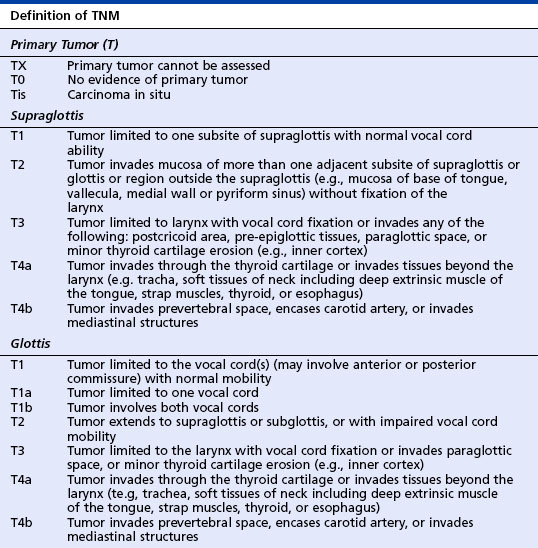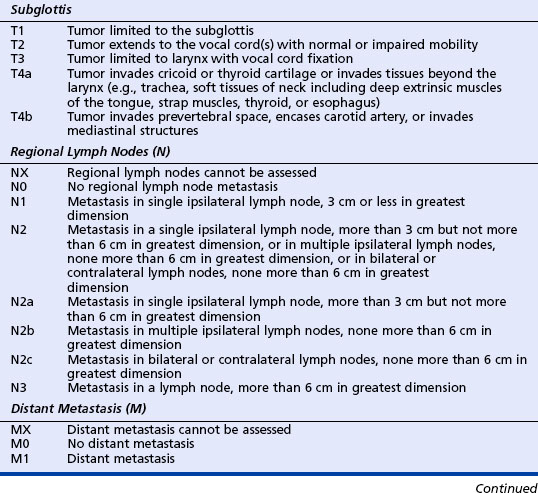Head and Neck Cancers
Laryngeal Cancer
DEFINITION
The larynx is divided into three anatomical regions:
• Supraglottic larynx includes the epiglottis, false vocal cords, ventricles, aryepiglottic folds, and arytenoids; approximately 34% of laryngeal cancers occur in this region.
• Glottis includes the true vocal cords and the anterior and posterior commissures; approximately 65% of laryngeal cancers occur in this region.
• Subglottic region begins about 1 cm below the true vocal cords and extends to the lower border of the cricoid cartilage or the first tracheal ring; approximately 1% of laryngeal cancers occur in this region.
ETIOLOGY AND RISK FACTORS
• Cigarette smoking is the single most important risk factor in head and neck cancer. The smoking attributable risk for laryngeal cancer is 79% in men and 87% in women.
• The combined use of alcohol and tobacco increases the risk of laryngeal cancer by about 50%. Alcohol and tobacco are believed to act synergistically. Alcohol itself is not a known carcinogen, and it may be that it damages the mucosa to allow increased cellular permeability to known carcinogens.
• Occupational exposure to wood dust
• Exposure to organic chemicals, coal products, cement, paint, varnish, and lacquer also increase risk.
• The human papillomavirus has been identified in some head and neck cancers.
• Personal history of laryngeal cancer—second primary tumors have been reported in up to 25% of patients whose initial lesion was controlled
CLINICAL STAGING
Staging is based on the best possible estimate of the extent of the disease before treatment according to the American Joint Committee on Cancer TNM classification (see table on pages 89–90).
TREATMENT
• Treatment often involves a multimodal approach. The choice of treatment is determined by the anticipated functional and cosmetic results and by the availability of the medical expertise required.
• Consideration is given to the efficacy of treatment and quality-of-life issues, such as preservation of voice in laryngeal tumors.
• Treatment for patients with recurrent lesions depends on the location and size of the recurrent lesion and on prior treatment.
Chemotherapy
• Historically, surgery and radiation therapy have formed the basis of therapy in head and neck tumors, with chemotherapy playing a minor role.
• Molecularly targeted therapies are available for head and neck cancers as well.
• Neoadjuvant therapy for locally advanced head and neck cancer is undergoing investigation. In this case, chemotherapy is given before surgery to facilitate organ preservation.
Radiation
• Although most early lesions can be cured by either radiation or surgery, radiation may be reasonable to preserve the voice, leaving surgery for salvage if needed.
• Radiation therapy is most commonly external beam, treating the primary site and regional lymph nodes.
• Intensity-modulated radiation therapy has become more widely available as a technique to limit normal tissue reactions, which can be considerable in the head and neck region.
• Patients who smoke while on radiation therapy appear to have lower response rates and shorter survival durations than those who do not; therefore, patients should be counseled to stop smoking before beginning radiation therapy.
• Research suggests that there is a significant loss of local control when radiation therapy was not delivered according to planned schedule; therefore, lengthening of the radiation schedule should be avoided whenever possible
Clarke L.K., Dropkin M.J. Site specific cancer series: head and neck cancer. Pittsburgh, PA: Oncology Nursing Society, 2006.
Jemal A., Siegel R., Ward E., et al. Cancer statistics, 2007. CA: A Cancer Journal for Clinicians. 2007;57:43–66.
National Cancer Institute. Laryngeal cancer PDQ. Retrieved Jan. 11, 2007, from http://www.cancer.gov/cancertopics/pdq/treatment/laryngeal/HealthProfessional, 2006.
Shah J. American Cancer Society atlas of clinical oncology: cancer of the head and neck. London: BC Decker, 2001.
Oral Cavity Cancer
ETIOLOGY AND RISK FACTORS
It has been estimated that over three quarters of head and neck cancers in the United States are related to tobacco and alcohol use. Alcohol and tobacco are believed to act synergistically. Alcohol itself is not a known carcinogen and it may be that it damages the mucosa to allow increased cellular permeability to known carcinogens. Risk factors include:
• Cigarette smoking is the single most important risk factor in head and neck cancer.
• Smokeless tobacco results in a 4- to 6-fold increase in cancers of the alveolar ridge and buccal mucosa.
• Occupational exposure to wood dust
• Exposure to organic chemicals, coal products, cement, paint, varnish, and lacquer
• Personal history of head and neck cancers have an increased chance of developing a second primary tumor
• The human papilloma virus (HPV 16)
• Diet low in fruits and vegetables
CLINICAL STAGING
Staging is done with the American Joint Committee on Cancer (AJCC) TNM classification (see table on page 92).
TREATMENT
• Treatment often involves a multimodal approach. Depending on the site and extent of the primary tumor and the status of the lymph nodes, the treatment of lip and oral cavity cancer may be by surgery alone, radiation therapy alone, or a combination of these.
• Early cancers (stage I and stage II) are highly curable by surgery or radiation therapy.
• The choice of treatment is determined by the anticipated functional and cosmetic results and by the availability of the medical expertise required.
• Most patients with stage III or stage IV tumors require multimodality approach of surgery and radiation therapy. Because of the risk of local recurrence and/or distant metastases in these patients, they should be considered for clinical trials.
• Treatment for patients with recurrent lesions will be dependent upon the location and size of the recurrent lesion as well as prior treatment.






